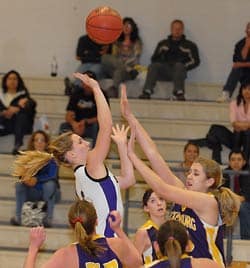Max James, co-founder of Camp Soaring Eagle, made an impassioned plea before the Yavapai County Planning and Zoning Commission.
Larson Newspapers
Max James, co-founder of Camp Soaring Eagle, made an impassioned plea before the Yavapai County Planning and Zoning Commission.
Speaking before that body in an effort in win approval for the camp, James said he wanted the camp on the Verde Valley School campus in the Village of Oak Creek because of a "vortex."
"I’m a believer," James said.
He referenced to the North Hawaii Community Hospital as support for this belief.
James said the hospital founder, Dr. Earl Bakken, told him he located the hospital on the north slope of a dormant volcano in Waimea, on the Big Island of Hawaii, because there is a vortex there also.
"All I can say is that the ‘vortex’ has had a very interesting impact on human behavior, particularly in the centuries past," James said. "I have seen the satellite magnetic images of the vortex locations."
James told the commissioners that he intended to "prime the pump" with his donation of $10 million to the camp.
George Reeve, the other co-founder, estimated the eventual cost will be $40 million.
Camp Soaring Eagle will be one of the Association of Hole in the Wall camps founded by actor Paul Newman. The name refers to an outlaw gang hideout in one of Newman’s popular movies, "Butch Cassidy and the Sundance Kid."
"Over 153,000 kids in Arizona can use the services of a camp like this," James said.
He told the commission of the despair and depression chronic or terminally ill children experience.
The children are brought to the camps in groups according to their illness. Children with a type of cancer will be at one camp while kids with cardiac problems are at another.
This way they lose the fear of doing things in front of others as often happens in other places, James said.
"Kids who have chest scars from cardiac operations will be able to run around without their shirts. Kids who have suffered hair loss because of cancer treatments will show up with wigs, but after the second day, they are relaxed enough to not wear them any more," James said.
"At these camps, kids can be themselves and do what they want. We tell them to climb that rock, shoot that basket, go for that swim," James said, quoting Newman.
James related a story of a father who wanted so badly for his child to get into a Hole in the Wall camp in the Northeast, that he slept outside the entrance to see if he could enroll his son when it opened in the morning. He was able to, but because a child died to make the space available.
James cited this as a reason for his desire to build another camp.
The commission gave its unanimous approval July 25.
The next hurdle for the camp will be the Yavapai County Board of Supervisor’s meeting Monday, Aug. 20 in Cottonwood.
Other than emotional reasons, James also cited the benefits of the camp to the business and communities.
Parents do not stay at the camp with their children, James said. They will need local hotel rooms and meals. He said the camp will eventually employ several locals and there will be
a "thousand" volunteer opportunities for Sedona residents.
The medical professionals staffing the camp will also be holding conferences in the area, James said.
Reeve said that the camp will be closely associated with the Phoenix Children’s Hospital and "it is committed to supporting the camp."
The camp will operate and host children from mid-May to mid-September each year. The camp could be available to other nonprofit organizations the rest of the year, Reeve said.
Through the Hole
in the Wall
In a discussion of procedures at the camp, James said campers are bunked six to eight to a room and that often their conversations are recorded.
"When the subject of death came up, one of the campers said that they do not really die. They just go through the hole in the wall," James said.
James said that this type of comforting behavior was one reason why they deal with one disease at a time. The recordings are used to refine treatment and help monitor the children’s conditions.



















